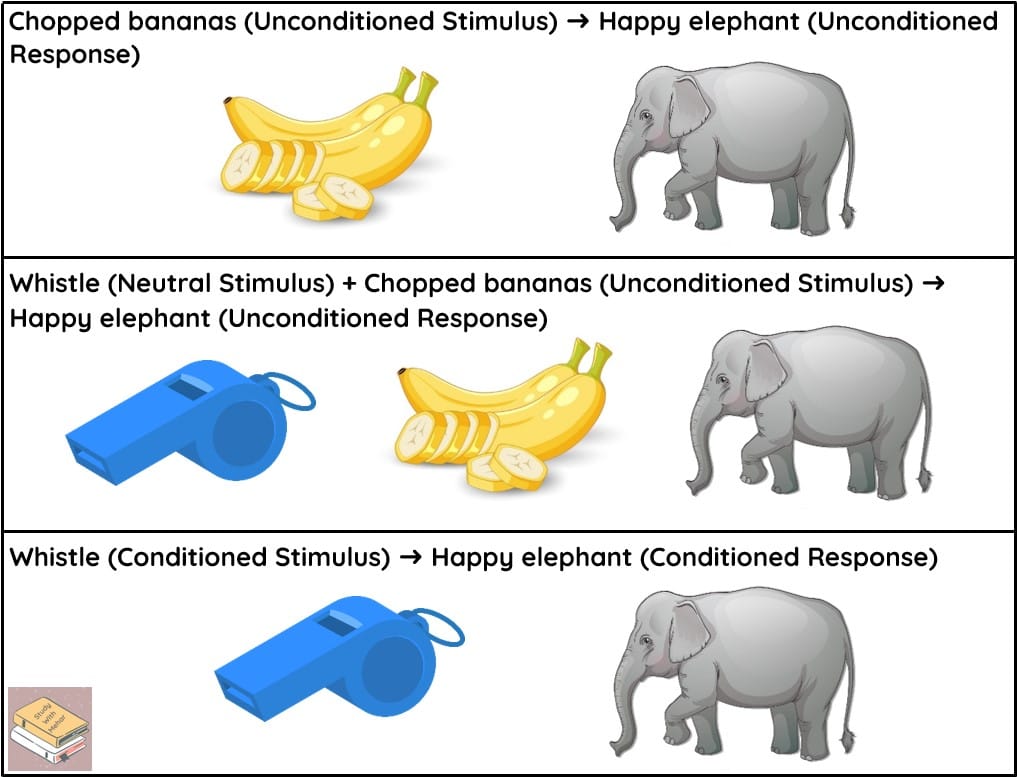Fagen et al. (2014)
Aim: To investigate whether secondary positive reinforcement can be used to train elephants to voluntarily complete a trunk wash, allowing them to be tested for TB.
Background
Dr. Ariel Fagan is a veterinary behaviourist of the American College of Veterinary Behaviour, who has conducted research at animal shelters and wildlife breeding centres.
In this research, captive elephants had to be tested for TB (Tuberculosis), so researchers wanted to train them to voluntarily do trunk washes to reduce stress.
Psychology Being Investigated
Researchers used positive reinforcement (a type of operant conditioning), by rewarding elephants for performing specific trunk movements in the correct order.
Rewards were in the form of primary and secondary reinforcers.
A primary reinforcer motivates a behaviour because it satisfies basic needs.
A secondary reinforcer reinforces a behaviour linked to a primary reinforcer.
Primary reinforcers = Chopped bananas (which satisfy hunger); given to the elephant each time it moved its trunk to the correct position.
Secondary reinforcer = A short blast from a whistle given at the same time as the bananas are presented. The whistle doesn’t meet any needs, but if they associate the whistle with the banana via classical conditioning, then the whistle itself becomes a powerful reinforcer.
The diagram below describes how classical conditioning turns the whistle blast into a secondary reinforcer.

Research Method, Design and Variables
Research method: A controlled observation, and a structured observation using a behavioural checklist.
Research design: Repeated measures design.
Independent variable: The cues/offers made to the elephants.
Dependent variable:
- Training duration from when the elephant is offered the first cue, to the last cue.
- The number of cues made to the elephant by the trainer.
- The success rate for each behaviour and sequence.
Grading behaviour: They passed if they showed the correct behaviour for 8/10 cues (80%) and were considered successful if the trainer thought they were ready to do real TB trunk-wash tests on their own.
From session 10 onwards, at every 5th session, they’d be tested on everything they learned until then.
Grading sequence of behaviours (for ex. trunk in hand then trunk up): Behaviour sequences were graded after grading behaviours individually (which achieved a 90% success rate). The success criterion was 80%. If a sequence failed, they’d then be tested on shorter sequences/individual behaviours.
The training stopped when elephants achieved an 80% success rate on the full five-stepped trunk wash sequence.
Sample
- 5 female elephants from Nepal ➜ 4 juveniles aged 5-7, and one adult aged at least 50 years old.
- Elephants were all tame, born in the stable, and none were pregnant.
- Elephants had no previous experience with secondary positive reinforcement training.
- Their mahouts were happy to participate and were present in all sessions to assure the trainers’ safety, but they didn’t interact with the elephants.
Procedure
Elephants were trained in the morning (7:30-10:00 am) and/or afternoon (4:00-7:00 pm) and were chained in their stalls at the stable.
To complete a trunk wash, elephants had to:
1. Put their trunk into the trainer’s hand so saline is inserted.
2. Lift their trunk and hold the fluid in.
3. Lower their trunk into a bucket.
4. Blow into the bucket to remove the fluid.
5. Hold the trunk steady before relaxing.
The behavioural checklist was used to measure how successful the elephants were in completing the behaviours in the checklist.
Methods used to train elephants:
- Capturing: Elephants were encouraged using rewards to perform normal behaviours as part of their usual routine. For example, if an elephant spontaneously lifted their trunk, she’d be given chopped bananas. This captured their behaviour, making it commonly repeated.
- Luring: Trainers encouraged unusual behaviours by positioning treats accordingly. For example, if the trainer needed the elephant to stretch its trunk out, they’d put a treat out of reach to lure them towards it.
- Shaping: Elephants were rewarded for all behaviours similar to the final goal. For example, they’d be rewarded for blowing fluid near the bucket. Although gradually they were only rewarded for accurate behaviours. I.e., blowing it into the bucket, hence shaping their behaviours over time.
- Secondary reinforcers: Through classical conditioning, they were taught to associate the whistle blast with the arrival of chopped bananas. This helped them quickly learn the association between their behaviour and the reward.
Once the elephants had learned all behaviours individually, trainers used verbal cues (one-syllable non words) to prompt elephants to perform the behaviours in sequences. Elephants were rewarded only if they completed the sequence in the right order, and gradually they learnt to perform all behaviours together.
The syringe was introduced after the elephants learned the trunk-wash behaviour. Since the syringe is an aversive stimulus (as they find it unpleasant), researchers desensitised them to it by gradually exposing it during each step. They also used counterconditioning to associate the syringe with the arrival of bananas, making the syringe a conditioned stimulus instead of an aversive stimulus.
Steps in introducing the syringe:
- The syringe would touch the outside of their trunks.
- The syringe would be placed inside their trunks.
- A drop of fluid was injected.
- 1-15ml was injected.
- 60ml was injected.
Results
- Elephants learned the trunk wash in 25-35 sessions.
- The average session duration was 12 minutes, ranging from 10 to 13 minutes.
- The average training time was 367 minutes, and sessions ranged from 257 to 451 minutes.
- Elephant 5 failed to learn the full wash sequence in the time available, she was not tested, or included in the results. She was never fully desensitised to the syringe, and if her training session time is added to the results, the average training time increases to 378 minutes.
- Elephants 2 & 4 didn’t fully learn to do the ‘trunk steady’ behaviour individually, but they did it as part of the full trunk wash.
- The success rate for individual behaviours & sequences increased from 39% after 10 sessions to 89.3% after 35 sessions.
- The practice required to master individual behaviours varied significantly. For example, ‘trunk in hand’ required 295 offers on average, whereas blow into bucket took only around 54 offers.
Conclusions
Secondary positive reinforcement is effective for training juvenile, traditionally trained elephants to voluntarily and reliably participate in a trunk wash.
Strengths
- The behavioural checklist had operationalised descriptions. For example, ‘bucket’ was described as ‘the distal end of the trunk is gently placed inside the bucket’. Operationalisation helped increase the reliability of the recordings.
- The mahouts did not speak or signal to the elephants upon request of researchers for the duration of the study. This means that changes in behaviour are solely due to secondary positive reinforcement given by trainers, hence proving the high validity of the results.
- Ethical guidelines of consent, psychological harm, & safety were followed as elephants were allowed to refuse participation by walking away. This helped reduce their distress, subsequently lowering the risk posed to trainers, observers, and mahouts of being physically harmed in the case the elephants got uncooperative.
- Elephant 1, the youngest got distracted and impatient if the training sessions were too long. Hence, they reduced the tests from 8-16 trials to just 5, to reduce the physiological distress she experienced.
- Data collection occurred in natural settings (where the elephants lived) with animal noises coming from the surrounding jungle. This increases the ecological validity of results, proving that findings would be similar if conducted on elephants in safari parks and zoos.
Weaknesses
- Only 5 elephants were used in the study, limiting the generalisability of results to male and adult elephants. The one & only adult elephant (elephant 5) had physical issues and failed to learn the full trunk wash. Adults may be able to learn the trunk wash using secondary positive reinforcement, but more research is required.
- Since the amount of times Elephant 1 was tested had been reduced, this means standardised procedures were not followed. Therefore, this limited the reliability of the results.
- Although the two observers had rated the elephants’ behaviour, they may not have found the same results due to subjective observer bias. Hence, using a camera to record their behaviour would have improved results as their validity could have been re-ensured.
- The elephants regularly failed the steady task – they only reached 70% accuracy instead of 80% because they were not good at the trunk-down task, hence reducing the validity of the results. The operational definition of ‘steady’ included completing 3 ‘trunk-here’ & ‘trunk down’ tests and 4 ‘trunk-up’ tests, but the elephants had trouble completing the ‘trunk-down’ task.
- The total training time is inaccurate since it included the time for training behaviours which weren’t part of the trunk wash, hence reducing the validity of the results. For example, 4 elephants were trained on the ‘trunk-out’ behaviour, which was later stopped since it wasn’t necessary.
- The measurement of the elephants’ performances was subjective since they had to decide if they felt the elephants successfully completed a full trunk wash. For example, the angle might have been difficult to interpret correctly, or a bit of liquid may have been spilled and the outcome could be reported differently by another observer.
Individual vs Situational Explanation
Elephant 5 failed to learn the trunk wash due to individual differences such as being older much than the others and having physical issues (abscess on her foot, and impaired vision). Contrastingly, her slow rate of learning might have also been due to situational factors – for example, the young calf who strayed into her stall might’ve distracted her.
Application to real-life
The study proves that captive elephants can be trained to cooperate for vet procedures in a safe & efficient way. The trunk wash is critical for managing TB in animal sanctuaries & zoos, and it ensures the health & well-being of animals, as well as humans who could potentially catch it from them.
Additionally, the technique of positive reinforcement can be used to teach other behaviours. This would reduce the need for manual restraints & sedatives when undergoing blood sampling and x-rays, reducing stress and improving well-being.
